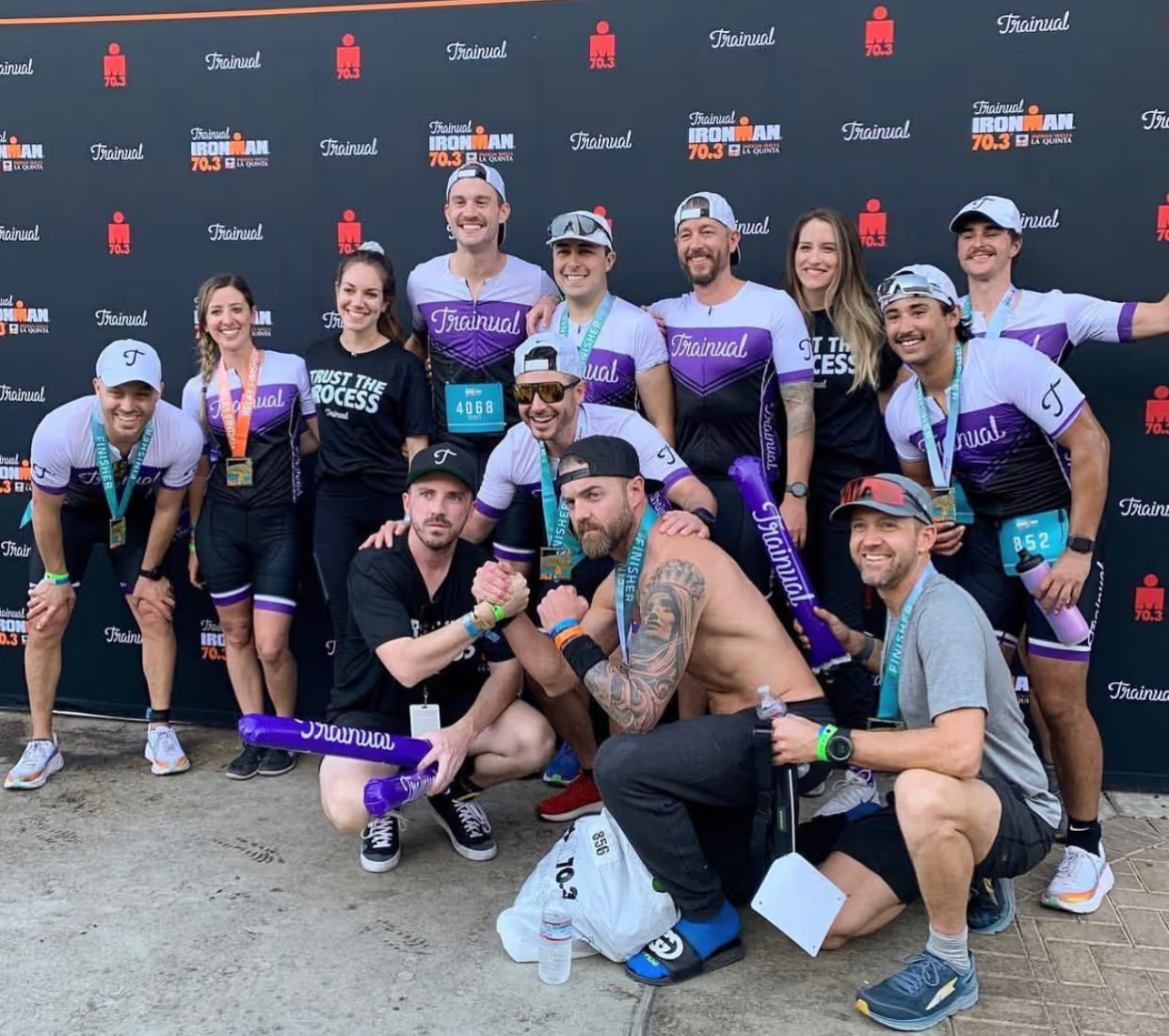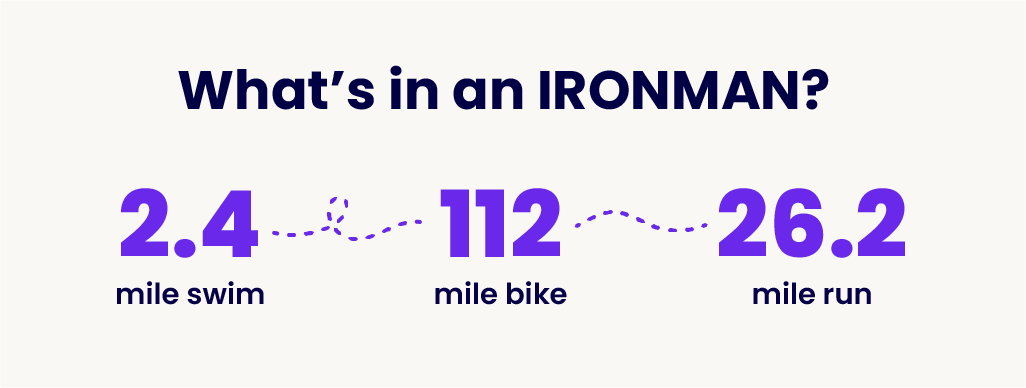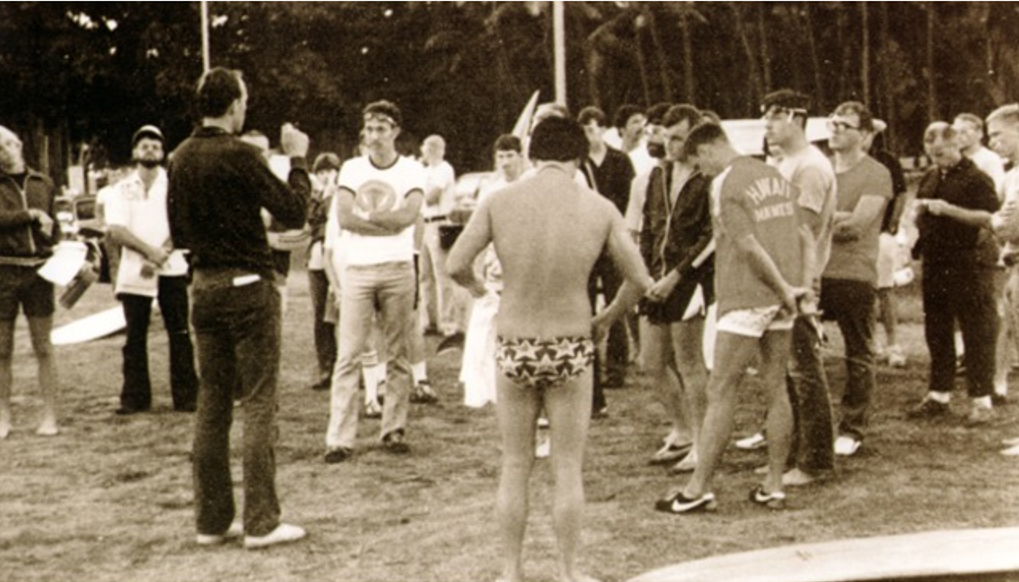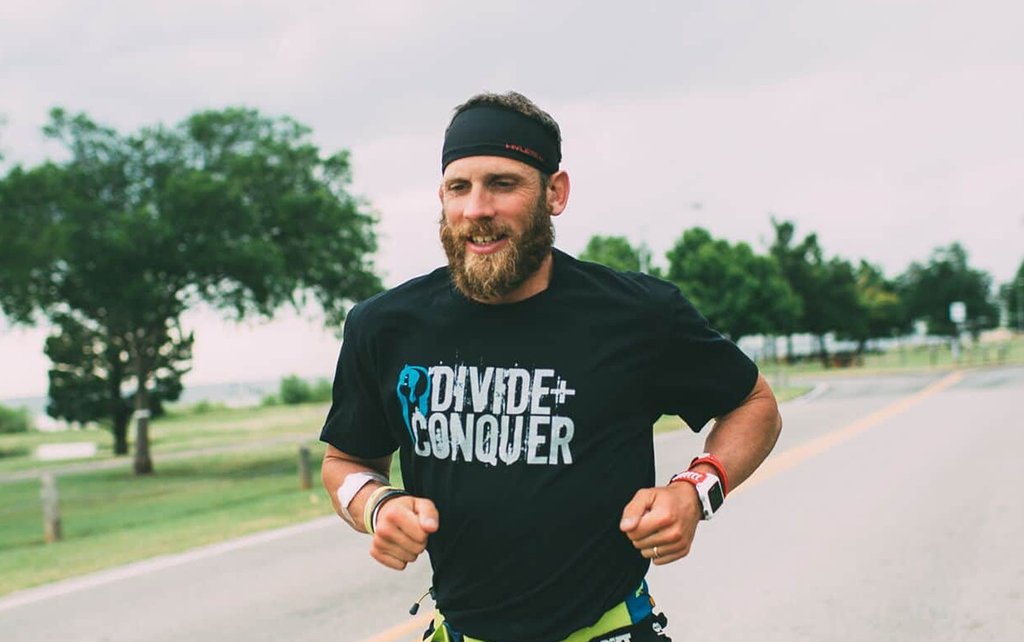
Articles
How IRONMAN Grew From 15 Customers To Millions Of Raving Fans
December 22, 2021

Every year, tens of thousands of people line up to swim 2.4 miles in open water, bike 112 miles, and run 26.2 miles. All in one day. And when they cross the finish line, they earn the right to call themselves an "IRONMAN.”
Even if you’ve never done one, chances are good that you’ve heard of IRONMAN. That’s because it’s widely considered the most grueling and rewarding race on the planet.
In hundreds of events in 55+ countries, millions of people have toed the line to race in an IRONMAN event. And some race finishers have even gotten the IRONMAN logo tattooed on their body. All because it serves as a symbol of one of the highest physical accomplishments on the planet.
But it wasn’t always this way. IRONMAN actually started as a small business with only one race and 15 customers. But by exposing their brand to the world and by building a culture where “anything is possible,” they grew into the massive success they are today.
Here’s how they did it.
👀 But first, want to see what kind of shape your business is in? Take the 2-minute quiz!
What is an IRONMAN triathlon?
The IRONMAN triathlon is an endurance race that consists of three sports: swimming, biking, and running. The traditional full-distance race includes a 2.4 mile open water swim, 112 mile bike ride, and a 26.2 mile run. A total of 140.6 miles - covered in a single day.

But the IRONMAN Group (the race’s parent company) also offers the same race at half those distances, called “IRONMAN 70.3.”
Either way, IRONMAN events are world famous for being incredibly difficult and one of the most extraordinary physical accomplishments that someone can do. For context, less than 1% of the population in the U.S. has completed a 26.2 mile marathon run. And even fewer have done so after swimming and biking 2.4 and 112 miles, respectively.
And that exclusivity is one of the reasons why people keep coming back. For the hundreds of thousands of people who’ve completed one, it means something special to be an IRONMAN.
How IRONMAN Started
Just like any business, IRONMAN started with an idea. And that idea came from Judy and John Collins, a Navy family who enjoyed being active and participating in triathlon races.
In 1975, they completed one of the first ever known triathlon events, which took place in San Diego. They fell in love with the sport, and when they moved to the island of Hawaii shortly thereafter, the Collins couple dreamed of hosting a triathlon in their new home state.
But they didn’t want it to just be any triathlon. They wanted it to be the ultimate test of human endurance.
So, they combined the distances from three of Hawaii’s toughest races: the 2.4 mile Waiki Roughwater Swim, the 112 mile annual O’ahu Bike Ride, and the Honolulu Marathon. And they wanted the race to be completed all in one day.
And when the course was designed, John spoke the now-famous words: “whoever finishes first, we’ll call them the Iron Man.”
At first, people laughed at the idea. They thought there was no way a race this challenging would attract anyone. And at first, they were kind of right. Only 15 people showed up to the inaugural 1978 race in O’ahu, Hawaii. And the same number of racers showed up for the second event in 1979.

But that second event is the one where people worldwide started to take notice. Starting with Sports Illustrated.
Barry McDermott, a reporter at the famed sports magazine, happened to be covering a golf event in Hawaii right before the second IRONMAN event was happening. When he heard some of the chatter surrounding the race, he thought it might be intriguing to cover.
In his race coverage, Barry described the race as a “legal way to prove toughness.” And when he published the 10-page story in Sports Illustrated, the article piqued some people’s interest. So much so that the following year brought over 100+ IRONMAN race participants to the island.
The finish that captivated the world
As the number of participants increased, so did the desire to actually watch the race. In fact, ABC’s Wide World of Sports decided to cover the 1980 race and broadcast it world-wide.
Many people were enamored that participants were willing to push themselves on the course for hours on end. And as more people watched, the race really started to grow.
In the year following that first ABC broadcast, 326 racers toed the line. And in 1982, that number grew to 500. And it was in that year when IRONMAN became a world-wide phenomenon.
In that race, Julie Moss, a college student participating in IRONMAN as part of a research project, led the women racers into the final miles of the marathon portion. She was an amateur athlete running her first race of this caliber, and no one expected this to happen.
As Julie approached the finish line, she fell to the ground. Her legs collapsed. Her body was shutting down and had reached its limit. Julie laid limp and lifeless on the ground for a few seconds. But then, she unbelievably got up.

Forcing her shaky legs to stand, she hobbled a few steps forward and fell again. She got back up. And despite her body failing, she crossed the finish line in second place.
ABC captured every moment of Julie’s finish. And the world watched her journey in awe. It was the epitome of persistence, grit, and resilience.
Her determination to finish showed people the value of IRONMAN as a test of toughness. One that shows people what humans are truly made of. And seemingly overnight, everybody wanted in on the action.
New races in new countries
After Julie Moss’s epic finish, IRONMAN exploded in popularity. The following 1983 race was the first year when the participant number hit capacity at 1,000 racers. In fact, the organization had to turn away 1,000 prospective racers to ensure participants’ safety.
But year after year, the number of racers trying to register continued to grow. They wanted to have a “Julie Moss” moment of their own. And they were willing to pay to do so. In fact, the Hawaii race has sold out every year since the 1982 race.
So, IRONMAN saw this as an opportunity to expand. In 1983, they decided to license out the IROMMAN name to another triathlon organizer in continental North America. And that triathlon took place in Penticton, Canada. Although there were only 23 racers who participated in that first international event, the event gained press coverage that spread like wildfire.
And in the following years, it gained enough worldwide interest that IRONMAN could license out its name to races in New Zealand and Japan. The business licensed the second race in the United States in Lake Placid, New York in 1990.
But IRONMAN wasn’t the only race gaining popularity at the time. The whole sport of triathlon was blowing up in the 1980s.
In 1989, the International Triathlon Union (ITU) was formed, which served as the first governing body for triathlons. And to debut it, the union held the first Triathlon World Championships that year in France.
With the Triathlon World Championships now contending with IRONMAN Hawaii as the premier event for the sport, IRONMAN knew it had to differentiate itself to remain on top. And that’s where the World Triathlon Corporation (WTC) came in.
Becoming a worldwide phenomenon
To keep expanding their brand across the globe and to better incentivize athletes to participate in their races, IRONMAN knew they needed a change.
That’s why the owners sold the company to James P. Gills, an avid IRONMAN fanatic, for $3M in 1990. And with that purchase, Gills created the World Triathlon Corporation to act as the parent company for IRONMAN. That way, Gills could put some more legitimacy and resources around expanding the IRONMAN brand.
As soon as WTC was created, IRONMAN increased their cash prize for the triathletes who finished in the top three spots. That way, the company could attract the best of the best triathletes in the world and maintain their coverage by the media, which had been a huge part of their early success.
Plus, they continued to license out their IRONMAN name to races in new territories, including China, Australia, Switzerland, and Germany. This landed IRONMAN even more global exposure.
But the company didn’t only want to expand to new countries; they wanted to make the race more accessible. Specifically, to people who didn’t want to endure the long distances of the original race.
So, they launched a new type of IRONMAN race in 2001 called IRONMAN 70.3. A race half the distance of a traditional IRONMAN, with a 1.3 mile swim, a 56 mile bike ride, and a 13.1 mile run.

With these new initiatives, the IRONMAN organization grew to 53 races in over 12 different countries by 2008. And as a result, they solidified their position as the most impressive triathlon event in the world.
Making customers’ dreams come true
During IRONMAN’s rapid expansion in the early 2000’s, Ben Fertic, WTC’s then-CEO, had a vision to make their customers’ experience much more memorable.
Because IRONMAN licensed their brand name out to independent race organizers, the experiences at each event were inconsistent. Meaning, you might get a completely different experience at an IRONMAN race in Pennington than Lake Placid - for better or worse.
But Fertic wanted every IRONMAN athlete to have an amazing raceday experience. “The only thing that ever really bothered me [when I was CEO] was when someone didn’t get the IRONMAN experience that they were hoping for,” Fertic said to Triathlete magazine. “At the end of the day, IRONMAN is in the dream fulfillment business, and our no. 1 job was to help our athletes make their dreams come true.”
And that meant not leaving athletes’ experiences up to chance. To make this happen, Fertic knew that IRONMAN had to take control of the experience. Meaning, they had to host the races themselves. So, WTC started producing IRONMAN events on their own, with IRONMAN Louisville being the first WTC-led triathlon (besides the original race in Hawaii) in 2007.
And as the years went by, they not only put on more self-produced races, but started acquiring their licenses back from the race organizers who hosted their legacy races. That way, they could standardize the experience and ensure that every racer felt like an IRONMAN.
And it worked! More races were added to the docket. More athletes were participating. And in 2011, WTC’s team was 50x bigger than it was in 2004. All thanks to Fertic’s vision to fulfill his customers’ dreams.
Enter China’s richest man
By August 2015, IRONMAN had ballooned to hosting 200 events in 27 countries, with nearly 250k registered athletes that year alone. The growth was impressive, and it caught the eye of Dalian Wanda Group, a Chinese property development company headed by Wang Jianlin.
At the time, Wang was the richest man in China, making his fortune off of buying and selling real-estate projects. But at that moment, he wanted to diversify his company’s efforts into sports by acquiring legendary brands and franchises. And given IRONMAN’s popularity, it was a no-brainer to start with them.
So, in August 2015, Dalian Wanda Group purchased WTC for $650M, giving Dalian the rights to the IRONMAN brand and control of all races. But their play here was bigger than just owning one of the most popular sports brands in the world; they also saw it as an opportunity to introduce IRONMAN to China.
At the time, IRONMAN didn’t have any races in China. And given how successful their races were in other Asian countries, it seemed like a safe bet to play. So, after the Dalian acquisition, IRONMAN opened up five races across the country.

Initially, because the triathlon sport was still relatively new to the Chinese community, it took a bit of trial and error to find success with the first few races.
Nonetheless, participation remained strong, and it led to more Chinese involvement in the sport. For example, in 2015, there were only two athletes from China participating in the IRONMAN World Championships. But by 2018, that number had grown to 33.
Pandemic pain
At the start of 2020, it seemed like IRONMAN was unstoppable, with races continually selling out across the globe. But then, the COVID-19 pandemic hit in February of that year. And as the world shut down, so did every single race that was scheduled for 2020.
And seemingly overnight, IRONMAN had virtually no revenue coming in for new races. To make things worse, parent company Dalian Wanda Group felt especially crushed by the pandemic, given most of their businesses relied on in-person events that weren’t happening. Their stock price plummeted, and they had to do something quick.
To recover for lost ground, Wanda sold IRONMAN to Advance Partners, a privately-owned conglomerate for $730M. Despite the state of in-person events, this was still a profit for Wanda Group.
But Advance knew that they were getting a bargain, even with all of the uncertainties that came with COVID-19. And all signs suggested that racers were hungry to get back to racing like normal.
Advance’s bargain paid off. All 2021 IRONMAN races in the United States and Canada sold out in January of that year - way before things were close to “normal.” Meaning, IRONMAN’s brand was as strong as ever coming out of the pandemic, thanks to their almost-fanatic customer base.
What’s IRONMAN up to now?
Today, IRONMAN operates 230+ events in 53 countries and continues to sell out nearly all of them. They’ve also added more events to their portfolio, such as the Rock-N-Roll Running Series and legendary UTMB World Series trail running events.
And with the growing number of events and participants, the organization has become increasingly aware of how they handle their volunteer training.
Since all the races are staffed primarily by volunteers, the company needs to get these volunteers up to speed quickly and ensure each one can deliver an IRONMAN-quality experience.
So, they’ve partnered with Trainual. And now, at races across the US, IRONMAN uses Trainual to get their volunteers up to speed in record time. With Trainual, they’re able to:
- Keep their volunteer training consistent throughout every race
- Put all of their training content on a mobile app, so volunteers don’t have to guess on what to do at the event
- Make the training content easy to digest and accessible anytime, anywhere
- Add videos to training content to show volunteers what an ideal race day looks like
That way, all of their volunteers are ready to support athletes on race day. And no one is confused about what they need to do.
As a result, an already incredible experience for athletes just got a whole lot better! Plus, IRONMAN feels more confident in adding even more races to their docket. A full-distance race in Juneau, Alaska and a 70.3 race in Dresden, Germany have already been added in 2021.
Today, IRONMAN continues to show racers and fellow small businesses alike what’s possible. Because like any other small business that scaled big, IRONMAN started as an idea with only a few customers.
But by fulfilling those customers' deepest wants and needs and by providing an unforgettable experience, the company has grown into an unforgettable brand. And that’s promising for any business who wants to accomplish the same kind of growth.
Similar Blog Posts










